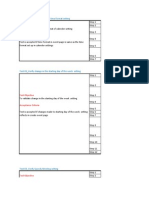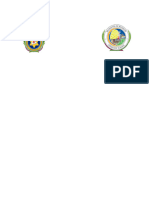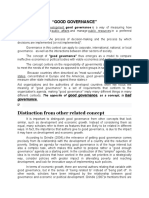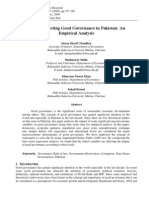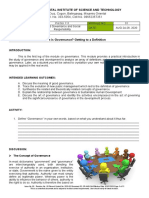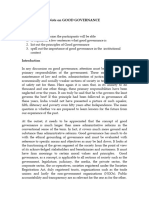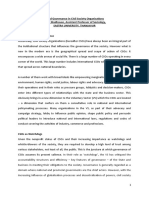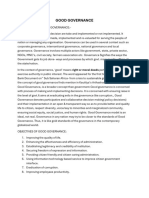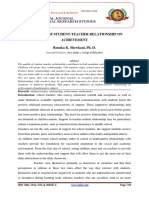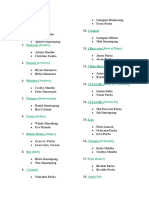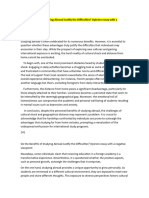Mal Governance and Rural Community: Ijers/ Bimonthly/Ekta & Madhurendra Kumar (522-530)
Mal Governance and Rural Community: Ijers/ Bimonthly/Ekta & Madhurendra Kumar (522-530)
Copyright:
Available Formats
Mal Governance and Rural Community: Ijers/ Bimonthly/Ekta & Madhurendra Kumar (522-530)
Mal Governance and Rural Community: Ijers/ Bimonthly/Ekta & Madhurendra Kumar (522-530)
Original Title
Copyright
Available Formats
Share this document
Did you find this document useful?
Is this content inappropriate?
Copyright:
Available Formats
Mal Governance and Rural Community: Ijers/ Bimonthly/Ekta & Madhurendra Kumar (522-530)
Mal Governance and Rural Community: Ijers/ Bimonthly/Ekta & Madhurendra Kumar (522-530)
Copyright:
Available Formats
IJERS/ BIMONTHLY/EKTA & MADHURENDRA KUMAR (522-530)
MAL GOVERNANCE AND RURAL COMMUNITY
Ekta1 & Madhurendra Kumar2
1
2
Research Scholar, Department of Political Science, CCS University, Meerut, U.P.
Professor & Campus Head, Department of Political Science, DBS campus, Kumaun
University, Nainital-263001, U. K.
Abstract
The governments both central and state have implemented a number of schemes particularly for rural
development. It needs to be noted whether the goal of development has been achieved, whether the
rural community is satisfied with the performance of the government, and whether people are reeling
under the pressure of mal- governance. It needs to be checked what are the main factors for the malgovernance if any, and what steps should be taken at rural level to make the governance more
effective, accountable and responsible. Responses to the queries can be obtained from the common
people. Therefore an empirical methodology has been used in an attempt to extract the view point of
the common people in respect of good governance and dignify of life. The government has schemes. In
order to empirically check it a random samples have been gathered and they have been provided a
close structure schedule for the purpose. Mostly respondents denied they revealed due to the
dominant attitude of bureaucracy peoples participation is marginal and corruption is rampant. A
weak will power and unwanted political interference are the main reason why bureaucracy has failed
in achieving the developmental goals.
Key words: corruption, good governance, mal- governance, political, rural.
Introduction
The concept of Good Governance derives its relevance in the context of mal governance
which includes non-feasance (a failure act of public servant), over-feasance (beyond limits)
and mal-feasance (wrongful conduct). In many countries the democratic form of government
has proved to be ineffective for checking swindling of public funds for private gains by the
elected leaders as well as permanent bureaucrats. Misuse of power, fraud, chicanery and
embezzlement of funds are systematically perpetrated by leaders of government and their
minions. Mal governance is found all around, especially in the developing countries, in
rampant degree. The concept of good governance becomes attractive as a remedy against his
state of affairs.
MAY-JUNE, 2016, VOL-I, ISSUE-VII
www.srjis.com
Page 522
IJERS/ BIMONTHLY/EKTA & MADHURENDRA KUMAR (522-530)
Meaning of Good Governance
Good governance has suddenly entered the vocabulary of public administration since
the 90s. This concept appears as a much publicized nostrum for the ailing third world
countries, but its real pedigree has to be traced to the crisis of first world administration in the
era of market dominance. Let us start on home ground first. How did Indian administration
get scent of good governance?
Roots and Concerns
The Conference of Chief Secretaries
The conference of Chief secretaries held on November 20, 1996, all of a sudden woke
up to the realization to that there was a crisis in Indian administration. It was necessary to
take corrective steps to arrest the present drift before it becomes too late. In the agenda note
entitled for an effective and responsive administration in India. It was admitted that:
The public administration and the civil service at all levels are passing through difficult times
in terms of eroded credibility and effectiveness of the civil service, growing public perception
of an unholy nexus between certain elements among politicians and civil servants and
criminals (as elaborated in the vohra committee Report), and increasing criticism of the low
level of honesty, transparency and accessibility to the political and bureaucratic elements in
charge of administration.
The imperative need was for governments at all levels to reinvent themselves and
redefine their roles and responsibilities and bring about reforms in all areas which have an
Impact on the lives of the people.
The public image of the bureaucracy, it was candidly confessed, was one of in
accessibility, indifference, procedure-orientation, poor quality and sluggishness, corruptionproneness and non-accountability for results. The need of the hour was therefore to assure
the people of India of an efficient, open, responsive, accountable, and clean and dynamically
adjusting administration at all levels. Urgent steps should be taken to restore peoples
confidence in the capacity and fairness of administration. Very significantly, the conference
recognized that governance has to extend beyond conventional bureaucracies to involve
actively citizens and consumer groups at all levels, to empower and inform the public and the
disadvantaged groups, and to ensure service delivery and programs execution through
autonomous elected local bodies.
There were, thus, three admissions: (a) There was a crisis in administration; (b) there
was urgent need to bring about reform in administration to make it people-sensitive, efficient
and cost effective; and (c) there was need for a change in the mindset to that governing could
MAY-JUNE, 2016, VOL-I, ISSUE-VII
www.srjis.com
Page 523
IJERS/ BIMONTHLY/EKTA & MADHURENDRA KUMAR (522-530)
be newly conceived as governance a wider term than formal government opening up,
in the process, possibilities of inclusion of other actors, such as citizens, consumer groups,
elected local bodies, etc.
World Bank prescription
As the Banks document, entitled governance and development (1992), puts it,
governance is defined as the manner in which power is exercised in the management of a
countrys economic and social resources for development. From its leading experience in
many developing countries, the bank came to realize that good governance is central to
creating and sustaining an environment which fosters strong and equitable development, and
it is an essential complement to sound economic politics. Three distinct aspects are
identified in the conceptualization of governance: (a) the form of political regime
(parliamentary or presidential, military or civilian, and authoritarian or democratic); (b) The
process by which authority is exercised in the management of a countrys economic and
social resources; and (c) the capacity of governments to design, formulate and implement
policies, and in general, to discharge government functions. The first aspect, it is admitted,
falls outside the Banks mandate. The focus of governance is, therefore, basically on the
second and third aspects.
Recounting its wide experience, the bank document narrates vividly the problems of
governance for instance, despite technical soundness, programs and projects have often
failed to produce desired results. Laws are not enforced properly and there are often delays in
implementation. Privatized production and market-led growth do not succeed unless investors
face clear rules and institutions. In the absence of proper accounting systems, budgetary
policies cannot be implemented or monitored. Many a time, procurement systems encourage
corruption and distort public investment priorities. Again, failure to involve beneficiaries and
others affected in the design and implementation of projects has often led to substantial
erosion of their sustainability.
Against this background of mal-governance, the bank has attempted to focus on some
of the key dimensions of governance, such as a public sector management, accountability,
the legal framework for development, and information and transparency, as already stated.
In modern-day shortly, it can show Good Governance in the forms of 4Ds & 4Ts.
4Ds-
Democratization
Decentralization,
Delegation of authority
De bureaucratization
MAY-JUNE, 2016, VOL-I, ISSUE-VII
www.srjis.com
Page 524
IJERS/ BIMONTHLY/EKTA & MADHURENDRA KUMAR (522-530)
4Ts-
Trained Administration
Technology
Technique
Transparency
We shall conclude that the end of good governance is happiness and welfare of the
people but, unlike Benthams utilitarianism. In India we have not approved charvak. We
believe that it is better to be a Gandhi or Socrates dissatisfied than a pig satisfied. The means
of good governance is promotion of rational will and moral power of people. Elites have to
be austere and they must throw their consumer goods out of the window as they had done in
case of western clothes and wine under swadeshi movement.
Hypotheses:
1. To evaluate the central and state level welfare schemes / Programs regarding rural
Development and examine whether they have been squeezed to their maximum capacity?
2. Impact of mal-governance on the rural community and Factors responsible for the same.
3. To suggest measure as to how the governance of grass root level may be made more
effective, accountable as responsive in bread based consistence with democratic
Principles.
Research Methodology
This study is based on both primary as well as secondary data. The primary data is collected
through the schedule from the beneficiaries and officials of various concerned department.
Besides this data collection, a few unofficial personal discussions and observation have also
been made to collect the true information on welfare schemes. Responses to the queries can
be obtained from the common people. Therefore an empirical methodology has been used in
an attempt to extract the view point of the common people in respect of Good Governance
and dignify of life. The government has schemes. In order to empirically check it a random
sample of 100 families out of a total of 944 families have been gathered, and they have been
provided a close structure schedule for the purpose. It is worth-while to note here that about
20 schemes and programs are being implemented by the central as well as state governments
in the village.
Result and discussion
The preamble of the Indian constitution speaks that the state shall try tirelessly to
achieve equality, liberty, justice and dignity for one and all. This is to be done within the
framework of socialism, secularism and parliamentary democracy. In the last half a decade
the governments both central and state have implemented a number of schemes particularly
MAY-JUNE, 2016, VOL-I, ISSUE-VII
www.srjis.com
Page 525
IJERS/ BIMONTHLY/EKTA & MADHURENDRA KUMAR (522-530)
for rural development. It needs to be noted whether the goal of development has been
achieved, whether the rural community is satisfied with the performance of the government,
and whether people are reeling under the pressure of mal- governance. It needs to be checked
what are the main factors for the mal- governance if any, and what steps should be taken at
rural level to make the governance more effective, accountable and responsible. It is quite
hard for a researcher, local or national, to seek the answers of the issues raised.
Table 1.1 Structures of Rural Development and Administration
N=100
S.No. Has the bureaucracy being able
to properly implement welfare
schemes? Yes/No
1.
Yes
2.
No
3.
Nil
Total
Frequency Percentage
25
28
47
100
25
28
47
100
Good governance is associated with efficient and effective administration in a
democratic framework. Respondents view have been shot on the point whether the
administration being able to properly implement these scheme. 25 percent respondents
responded positively. 28 percent respondents denied they revealed due to the dominant
attitude of bureaucracy peoples participation is marginal and corruption is rampant. A weak
will power and unwanted political interference are the main reason why bureaucracy has
failed in achieving the developmental goals.
Table 1.2 Public Responsibility And Administration
N=100
S.No. Does the Administration Frequency
provide
you
with
necessary
information
when you ask for them?
Y/N
1.
Yes
32
2.
No
68
Total
100
Percentage
32
68
100
Respondents views have been shot on the point whether the bureaucracy provide you
with necessary information when you ask for them, 32 percent respondents replied positively
they belong to high or middle class and they have connection with the bureaucrats in any
ways. 68 percent respondents denied they revealed that bureaucrats behaviour is very rude
and they have dominant attitude. When they go to take information in concern department,
the bureaucrats behave like a king and look them such as beggars.
MAY-JUNE, 2016, VOL-I, ISSUE-VII
www.srjis.com
Page 526
IJERS/ BIMONTHLY/EKTA & MADHURENDRA KUMAR (522-530)
Table 1.3 Rural Development and Efficiency of Administration
N=100
S.No. Has the administration
in comparison with the
past, been simplified and
more active? Yes/No
1.
Yes
2.
No
Total
Frequency Percentage
38
62
100
38
62
100
Conceptually, the bureaucracy has guardian, neutral and committed image in a
political system. It is natural bureaucracy which should be given preference in a democratic
system. To examine the fact, the respondents have been asked administration has been
simplified and more active in comparison with the past, 38 percent respondents replied
positively that they are more active than before. But 62 percent respondents replied
negatively they are mostly illiterate and less aware about the laws like Right to Information.
It is basic objective of policy planning and implementation that people should get what they
need. Their aspirations should be fulfilled. Hence, the objective of the administration should
be to implement the policies in such a way that the very objective is achieved. This can be
ascertained by the peoples level satisfaction on this count.
Table 1.4 Accountability and Administration
N=100
S.No. Is the administration
responsive
and
accountable to you? Y/N
1.
Yes
2.
No
Total
Frequency Percentage
21
79
100
21
79
100
To ascertain, how bureaucracy responsive and accountable to the people ? 79 percent
of the respondents responded that they have to face many problems to getting ration, pension,
aid, and loan etc. due to corruption. Then how can say that the administration is responsive
and accountable. It is corruption in rural development planning which have an effect on the
whole planning prospects negatively. 21 percent of the respondents who considered that
administration is responsive and accountable, they belong to creamy lair of the universe and
without need they are getting pension and aid etc. because of their power influence.
Table 1.5 Structure of E-Governance
N=100
MAY-JUNE, 2016, VOL-I, ISSUE-VII
www.srjis.com
Page 527
IJERS/ BIMONTHLY/EKTA & MADHURENDRA KUMAR (522-530)
S.No. Do you think that in
administrations different
field new technologies and
techniques
are
being
used? Y/N
1.
Yes
2.
No
Total
Frequency Percentage
3
97
100
3
97
100
When enquired about the new technologies and techniques are being used in
administrations different field 97 percent of respondents replied negatively. Only 3 percent
respondents responded affirmatively that new techniques are being used but only in the
agricultural field by using new technological instruments. It should mention here that
government of India established Farmer Call Centers where Farmer can get any information
regarding farming but most of the farmers are unknown about this. Basically E- Governance
belongs to computerization of all documents recorded and uploaded that process of all
departments let be fast. But in the block of study area it has not seen.
Table 1.6 The Universe and Good Governance
N=100
S.No. Response
1.
Yes
2.
No
Total
Frequency
3
97
100
Percentage
3
97
100
After identify the concept of Good Governance it has tried to ascertain from the
respondents. If the good governance consists in a Transparent, Accountable, Efficient and
Development Oriented Policy then, is there the nature of governance in your locality? Out of
100; 3 percent respondents responded positively, they all were above 70 years old illiterate
domestic ladies, 97 percent respondents denied. They told due to corruption, dominant and
weak will power of bureaucrats all development programs or scheme become fail. So it is
more need to be done to establish Good Governance or Ram Rajya in the study area.
The
detail
of
expectations
level
of
the
respondents,
from
the
governance/administration in different sectors may be observed in the table below.
Table 1.7 Suggestions
N=100/3*
S.No. Administration sector
1.
Administration should be alert,
accountable & capable
2.
Strongly advertise the welfare
schemes
3.
Establish a police station to
remove the crime and corruption
4.
More openness
MAY-JUNE, 2016, VOL-I, ISSUE-VII
Frequency Percentage
79
35.7
21
9.6
17
7.6
18
8.1
www.srjis.com
Page 528
IJERS/ BIMONTHLY/EKTA & MADHURENDRA KUMAR (522-530)
5.
Rural Autonomy
Social sector
Health care
Focus on sanitation
Only needy person should get the
aid
Focus on women and childrens
programs
Economic sector
Loan process from bank and
governmental agencies should be
simple
Employment
Development
of
cottage
industries
Total
6.
7.
8.
9.
10.
11.
12.
0.4
4
28
24
1.8
12.6
10.6
20
1.3
4
2
1.8
0.8
221
100
* Note: Maximum three suggestions from each respondent.
As far as the nature of the suggestions of the common people maximum three
suggestions to be suggested. In the area of social, administrative and economic concern they
are very ordinary. In administrative segment the common suggestions of the respondents
belong to efficiency of administration. 61.4 percent suggestions have come from
administrative sector itself. Out of these 35.7 percent have suggested accountable and capable
administration, 9.6 percent propaganda of welfare schemes, 7.6 percent to remove corruption
and crime, 8.1 percent want more openness, 0.4 percent want autonomy.
Total 34 percent suggestions have come from Social Sector, 1.8 percent suggested
health care need more attention, 12.6 percent focus on sanitation, 10.6 percent suggested that
only needy person should get benefit not creamy lair. 9 percent focus on women and
childrens programs.
In economic segment total 3.9 percent suggestions have come, out of these 1.3 percent
attention on loan process should be easy. 1.8 percent suggested improvement of employment
and 0.8 percent focus on development of cottage industries.
However,
it
is
seen
that
the
common
mens
expectation
from
the
governance/administration as such that a democratic welfare system must provide this to its
people.
It is needed that each problem is addressed quickly and resolved effectively and
efficiently within the democratic framework so that peoples problems are resolved without
delay. It needs to be kept in the mind that democracy is a system in which the governments
are accountable to the people who have voted them to power and this accountability can only
be measured in terms of the degree of governance.
MAY-JUNE, 2016, VOL-I, ISSUE-VII
www.srjis.com
Page 529
IJERS/ BIMONTHLY/EKTA & MADHURENDRA KUMAR (522-530)
References
Annual Report (2009). Government of India, 2009.
Ashok, M. (1998). Reinventing Government for Good Governance. Indian Journal of Public
Administration, vol. XLIV, No.3.
Bhattacharya M. (1998). Conceptualizing Good Governance. IJPA, Vol. XLIV.
Chaturvedi S.K. (2005). Facets of Good Governance. Refresher course, C.C.S. University, Meerut,
U.P., 21 May-11 June.
Dey Bata K. (1998). Defining Good Governance. IJPA, vol. XLIV, No.3.
Dwivedi O.P. (1998). Common Good and Good Governance. IJPA, Vol. XLIV No.3.
Indian Infrastructure Report (2008). Government of India.
Kashyap C. Subash (ed.). (1997). Crime, Corruption and Good Governance.
Minocha O.P. (1997). Good Governance: Management in Government. IJPA, vol. XXIX, No.3.
Oxford Reference Dictionary, 1995.
Sengupta B. (1996). India: The Problem of Governance Delhi, Konark.
Sharma L.N and Sharma S. (1998). Koutilyan Indicators of Good Governance. IJPA, vol. XLIV, No.3.
Times of India, Patna, August 15, 1998.
Uttar Pradesh Development Report (2008) Vol. II.
www.ddws.nic.in
www.drd.nic.in
www.rural.nic.in
MAY-JUNE, 2016, VOL-I, ISSUE-VII
www.srjis.com
Page 530
You might also like
- Directing The Documentary - 7th Edition - Michael RabigerDocument1,050 pagesDirecting The Documentary - 7th Edition - Michael Rabigerdanielmeench100% (1)
- Googel Calendar Test CaseDocument6 pagesGoogel Calendar Test CaseJyotidesai25% (4)
- Concept of Good GovernanceDocument18 pagesConcept of Good GovernancearchanavedantamNo ratings yet
- Biography of Imam Malik Ibn AnasDocument8 pagesBiography of Imam Malik Ibn AnasRey Jaycelle BasilioNo ratings yet
- Admin TheoryDocument65 pagesAdmin Theory2382tanveenNo ratings yet
- Admin Law ProjectDocument10 pagesAdmin Law Projectejbeth01No ratings yet
- Good GovDocument23 pagesGood GovObedLalmalsawmaNo ratings yet
- Deepika ReportDocument51 pagesDeepika ReportMohit PacharNo ratings yet
- P Governance and Ethics in GovernanceDocument28 pagesP Governance and Ethics in Governancenperson1011No ratings yet
- Chapter - 1Document84 pagesChapter - 1Mohit PacharNo ratings yet
- Seron Final Exam IntroPagDocument12 pagesSeron Final Exam IntroPagting02191997No ratings yet
- GovernanceandRTIinIndiaSHEILA RAIDocument14 pagesGovernanceandRTIinIndiaSHEILA RAISoumya PandeyNo ratings yet
- Public Sector Manajemen A Millennial InsightDocument33 pagesPublic Sector Manajemen A Millennial InsightAldy WigunaNo ratings yet
- Study Material Study Material: Handout Handout-20Document11 pagesStudy Material Study Material: Handout Handout-20Nikhil nainNo ratings yet
- Good GovernanceDocument6 pagesGood GovernanceJohar NawazNo ratings yet
- DEOCAMPO PublicAdministrationAsGovernanceDocument10 pagesDEOCAMPO PublicAdministrationAsGovernanceCarl SantosNo ratings yet
- Ecology of Pa by Atty. OdilonDocument48 pagesEcology of Pa by Atty. OdilonLeedmo ClaverNo ratings yet
- Governance and Its IndicatorsDocument60 pagesGovernance and Its IndicatorsMhoe Pat Kay100% (1)
- Challenges and Prospects of Good Governance in Reduction of Poverty A Case Study of Buee Town 01 Kebele EthiopiaDocument15 pagesChallenges and Prospects of Good Governance in Reduction of Poverty A Case Study of Buee Town 01 Kebele EthiopiaBEALU GIRMAYENo ratings yet
- Why Public Sector ReformDocument4 pagesWhy Public Sector ReformGebretsadik AwgichewNo ratings yet
- Pa 113 SG 3 1Document7 pagesPa 113 SG 3 1Roneil LaplanaNo ratings yet
- "Good Governance": Distinction From Other Related ConceptDocument7 pages"Good Governance": Distinction From Other Related ConceptRio Albarico100% (1)
- Factors Affecting Good Governance in PakistanDocument10 pagesFactors Affecting Good Governance in PakistanRizii RaoNo ratings yet
- MOIST Governance & Social Responsibility Module 01Document11 pagesMOIST Governance & Social Responsibility Module 01MARJUN ABOGNo ratings yet
- HIST 348 Module 4Document47 pagesHIST 348 Module 4Anubhuti AwasthiNo ratings yet
- Good Urban Governance DefinitionDocument4 pagesGood Urban Governance DefinitionKirkNo ratings yet
- Communique CorruptionDocument3 pagesCommunique CorruptionErnest PaulNo ratings yet
- Good Governance and Public Policy in India: V Mallika VedanthamDocument12 pagesGood Governance and Public Policy in India: V Mallika Vedanthamdurgesh kumar gandharveNo ratings yet
- Draft Ads 656 - Seminar in Pub. MGTDocument12 pagesDraft Ads 656 - Seminar in Pub. MGTsyahiran 19No ratings yet
- Nasrullah Economic GovernanceDocument13 pagesNasrullah Economic GovernanceNafi AhmedNo ratings yet
- Good GovernanceDocument11 pagesGood GovernanceSheikh Nabeel100% (1)
- LM 1 Midterm IPADocument5 pagesLM 1 Midterm IPAglxyyshnNo ratings yet
- Economics IDocument12 pagesEconomics Isanskrati116-20No ratings yet
- HRD in Other SectorsDocument147 pagesHRD in Other SectorsMandy Singh100% (4)
- Governance and InstitutionsDocument181 pagesGovernance and Institutionsmuhammedmam843No ratings yet
- BSSD 103 Governance and Development Assignment 1 Part 1 Semester 1Document12 pagesBSSD 103 Governance and Development Assignment 1 Part 1 Semester 1TatendaNo ratings yet
- Promoting Good Governance in Public Institution of NigeriaDocument10 pagesPromoting Good Governance in Public Institution of NigeriaIfeOluwaNo ratings yet
- Social Audit Is Proposed As A Supplement To Conventional Audit To HelpDocument6 pagesSocial Audit Is Proposed As A Supplement To Conventional Audit To HelpDipu SinghNo ratings yet
- ggDocument5 pagesggrabitamahakul02No ratings yet
- A Tale of Accountability Trivia What IsDocument17 pagesA Tale of Accountability Trivia What IsSadiq Khan NasarNo ratings yet
- Good Governance-Definitions, 8 Characteristics, and ImportanceDocument6 pagesGood Governance-Definitions, 8 Characteristics, and Importancesatyam skNo ratings yet
- JTF Presentation For PCL LA LU HubDocument44 pagesJTF Presentation For PCL LA LU HubJane Tadina FloresNo ratings yet
- Contemporary Issues in Development AdministrationDocument12 pagesContemporary Issues in Development AdministrationBen Asuelimen IJIENo ratings yet
- Deepali SinghDocument7 pagesDeepali SinghBijit BasumataryNo ratings yet
- Lecture 2 - GoodGov FrameworkDocument49 pagesLecture 2 - GoodGov FrameworkBigay, John ThomasNo ratings yet
- Assignment Group PAD102Document13 pagesAssignment Group PAD1022022897562No ratings yet
- Adminstration Law Good GovernanceDocument12 pagesAdminstration Law Good GovernanceAshishSharmaNo ratings yet
- Exam - Catedra I CPR 802Document3 pagesExam - Catedra I CPR 802Michael ReveloNo ratings yet
- ProjectDocument28 pagesProjectsumonu mongrineNo ratings yet
- Role of Public Administration in Good Governance PDFDocument4 pagesRole of Public Administration in Good Governance PDFMary Mhelbone Banao100% (2)
- Elements of Good GovernanceDocument4 pagesElements of Good GovernancekennethNo ratings yet
- Assignment 1 - Gov and DevtDocument3 pagesAssignment 1 - Gov and DevtTin PrimeNo ratings yet
- New Governance AssignmentDocument16 pagesNew Governance AssignmentingridNo ratings yet
- Civil Society and Good GovernanceDocument5 pagesCivil Society and Good Governancesrirangam704143100% (1)
- 1Document9 pages1JONUS DSOUZANo ratings yet
- Inshira Dansal - 241B (Final Exam)Document6 pagesInshira Dansal - 241B (Final Exam)inshiraNo ratings yet
- Good GovernanceDocument4 pagesGood Governanceyadavaarju464No ratings yet
- Can Public Management Contribute To Governance in Developing Countries?Document13 pagesCan Public Management Contribute To Governance in Developing Countries?Lexi BrownNo ratings yet
- Local and Regional Governance: Learning ModulesDocument9 pagesLocal and Regional Governance: Learning ModulesTherese Angelu AbionNo ratings yet
- Development and Governance - AssignmentDocument32 pagesDevelopment and Governance - AssignmentKhondokar Sabera Hamid100% (8)
- Participatory GovernanceDocument19 pagesParticipatory GovernanceSyeda SameehaNo ratings yet
- Good Governance: Principles and Practices for Modern StatesFrom EverandGood Governance: Principles and Practices for Modern StatesNo ratings yet
- Dr. Pardeep Thakral (VED PRAKASH 2)Document5 pagesDr. Pardeep Thakral (VED PRAKASH 2)INTERNATIONAL JOURNAL FOR EDUCATIONAL RESEARCH STUDIESNo ratings yet
- Sonal Patil 3 PDFDocument4 pagesSonal Patil 3 PDFINTERNATIONAL JOURNAL FOR EDUCATIONAL RESEARCH STUDIESNo ratings yet
- ApomswDocument7 pagesApomswINTERNATIONAL JOURNAL FOR EDUCATIONAL RESEARCH STUDIESNo ratings yet
- Dr. Renuka K Shewkani.Document7 pagesDr. Renuka K Shewkani.INTERNATIONAL JOURNAL FOR EDUCATIONAL RESEARCH STUDIESNo ratings yet
- Arvind Kumar GillDocument10 pagesArvind Kumar GillINTERNATIONAL JOURNAL FOR EDUCATIONAL RESEARCH STUDIESNo ratings yet
- Ashish MishraDocument6 pagesAshish MishraINTERNATIONAL JOURNAL FOR EDUCATIONAL RESEARCH STUDIESNo ratings yet
- Gunjan Sharma (Ref - Bharat Joshi)Document5 pagesGunjan Sharma (Ref - Bharat Joshi)INTERNATIONAL JOURNAL FOR EDUCATIONAL RESEARCH STUDIESNo ratings yet
- A Study On Mental Health Problems Among Teacher Trainees Thumma SrinivasaraoDocument4 pagesA Study On Mental Health Problems Among Teacher Trainees Thumma SrinivasaraoINTERNATIONAL JOURNAL FOR EDUCATIONAL RESEARCH STUDIESNo ratings yet
- Rekha Soni (REF-Inderjeet Singh)Document5 pagesRekha Soni (REF-Inderjeet Singh)INTERNATIONAL JOURNAL FOR EDUCATIONAL RESEARCH STUDIESNo ratings yet
- Veena Article - 1 Kiran SoniDocument12 pagesVeena Article - 1 Kiran SoniINTERNATIONAL JOURNAL FOR EDUCATIONAL RESEARCH STUDIESNo ratings yet
- 1.kalpana M. MoreDocument7 pages1.kalpana M. MoreINTERNATIONAL JOURNAL FOR EDUCATIONAL RESEARCH STUDIESNo ratings yet
- JaychandranDocument5 pagesJaychandranINTERNATIONAL JOURNAL FOR EDUCATIONAL RESEARCH STUDIESNo ratings yet
- 3.Dr. Arpita VermaDocument12 pages3.Dr. Arpita VermaINTERNATIONAL JOURNAL FOR EDUCATIONAL RESEARCH STUDIESNo ratings yet
- 3 Khan Tanveer HabeebDocument5 pages3 Khan Tanveer HabeebINTERNATIONAL JOURNAL FOR EDUCATIONAL RESEARCH STUDIESNo ratings yet
- Sabahat AslamDocument8 pagesSabahat AslamINTERNATIONAL JOURNAL FOR EDUCATIONAL RESEARCH STUDIESNo ratings yet
- Santosh MishraDocument5 pagesSantosh MishraINTERNATIONAL JOURNAL FOR EDUCATIONAL RESEARCH STUDIESNo ratings yet
- Vishavpreet KaurDocument5 pagesVishavpreet KaurINTERNATIONAL JOURNAL FOR EDUCATIONAL RESEARCH STUDIESNo ratings yet
- 8 Dr. Ujjawala SadaphalDocument9 pages8 Dr. Ujjawala SadaphalINTERNATIONAL JOURNAL FOR EDUCATIONAL RESEARCH STUDIESNo ratings yet
- 16.prof - Rathod Gulab SirDocument7 pages16.prof - Rathod Gulab SirINTERNATIONAL JOURNAL FOR EDUCATIONAL RESEARCH STUDIESNo ratings yet
- Dr. Veena JhaDocument4 pagesDr. Veena JhaINTERNATIONAL JOURNAL FOR EDUCATIONAL RESEARCH STUDIESNo ratings yet
- 19.prof - Kambale MadamDocument3 pages19.prof - Kambale MadamINTERNATIONAL JOURNAL FOR EDUCATIONAL RESEARCH STUDIESNo ratings yet
- 7 Harshdeep BhatiyaDocument14 pages7 Harshdeep BhatiyaINTERNATIONAL JOURNAL FOR EDUCATIONAL RESEARCH STUDIESNo ratings yet
- Dr. Manju Maria SolomonDocument7 pagesDr. Manju Maria SolomonINTERNATIONAL JOURNAL FOR EDUCATIONAL RESEARCH STUDIESNo ratings yet
- Self-Acceptance and Adjustment Among The Secondary School Students-An AnalysisDocument11 pagesSelf-Acceptance and Adjustment Among The Secondary School Students-An AnalysisINTERNATIONAL JOURNAL FOR EDUCATIONAL RESEARCH STUDIESNo ratings yet
- Empowerment of Teacher EducationDocument3 pagesEmpowerment of Teacher EducationINTERNATIONAL JOURNAL FOR EDUCATIONAL RESEARCH STUDIESNo ratings yet
- Kusum SharmaDocument9 pagesKusum SharmaINTERNATIONAL JOURNAL FOR EDUCATIONAL RESEARCH STUDIESNo ratings yet
- Prof. Kulkarni V VDocument3 pagesProf. Kulkarni V VINTERNATIONAL JOURNAL FOR EDUCATIONAL RESEARCH STUDIESNo ratings yet
- 12.prof - Darandale J.B.Document4 pages12.prof - Darandale J.B.INTERNATIONAL JOURNAL FOR EDUCATIONAL RESEARCH STUDIESNo ratings yet
- Emerging Trends in Teacher Education Shri. Ingale Ganesh PopatDocument6 pagesEmerging Trends in Teacher Education Shri. Ingale Ganesh PopatINTERNATIONAL JOURNAL FOR EDUCATIONAL RESEARCH STUDIESNo ratings yet
- Changing Classroom Practice Through Blogs and VlogsDocument12 pagesChanging Classroom Practice Through Blogs and VlogsMary Grace JimenezNo ratings yet
- Chronic Pain - WikipediaDocument1 pageChronic Pain - WikipediaBadhon Chandra SarkarNo ratings yet
- Archives of Sexual Behavior Volume 22 Issue 4 1993 (Doi 10.1007/bf01542119) Milton Diamond - Homosexuality and Bisexuality in Different PopulationsDocument20 pagesArchives of Sexual Behavior Volume 22 Issue 4 1993 (Doi 10.1007/bf01542119) Milton Diamond - Homosexuality and Bisexuality in Different PopulationsAmarendra GandhiNo ratings yet
- 3q-Reading and WritingDocument3 pages3q-Reading and WritingClydelle PorrasNo ratings yet
- Barlow SummaryofexpertrecdDocument31 pagesBarlow SummaryofexpertrecdBangun Sandro Viali DondokambeyNo ratings yet
- Nerl Work ShopDocument237 pagesNerl Work ShopRatan KotipalliNo ratings yet
- Report Writing Format-General FormatDocument5 pagesReport Writing Format-General FormatritikaritikaNo ratings yet
- Hyperammonemia in ReviewDocument16 pagesHyperammonemia in ReviewIka KusumaNo ratings yet
- Language Reference: InversionDocument9 pagesLanguage Reference: InversionRNo ratings yet
- 5g Radio Access Network Architecture EricssonDocument18 pages5g Radio Access Network Architecture EricssonMuhammad AzfarNo ratings yet
- Essent 1.1 PDFDocument90 pagesEssent 1.1 PDFSpidey ReddyNo ratings yet
- Kel. Parguru MaluaDocument4 pagesKel. Parguru MaluapardameanNo ratings yet
- ST Patrick Geddes: Father of Modern Town PlanningDocument11 pagesST Patrick Geddes: Father of Modern Town PlanningSanjana SudeepNo ratings yet
- Personal Selling (Preparation and Process)Document20 pagesPersonal Selling (Preparation and Process)MadhuNo ratings yet
- Fascinate, Revised and Updated: How To Make Your Brand Impossible To ResistDocument6 pagesFascinate, Revised and Updated: How To Make Your Brand Impossible To ResistNay Margarido100% (1)
- MenoDocument2 pagesMenoTanu shreeNo ratings yet
- Quadratic EquationsDocument12 pagesQuadratic EquationsRaymondNo ratings yet
- Task 11Document2 pagesTask 11Romeo Cabrera Jr.No ratings yet
- Senior Citizen V ComelecDocument2 pagesSenior Citizen V Comelecjodelle11No ratings yet
- Business Plan 3 CompleteDocument19 pagesBusiness Plan 3 Completewilson100% (1)
- Do The Benefits of Study Abroad Justify The DifficultiesDocument3 pagesDo The Benefits of Study Abroad Justify The DifficultieswestberganaluciaNo ratings yet
- 10.1186 - s13058 017 0846 1Document14 pages10.1186 - s13058 017 0846 1Ober Van Gómez LópezNo ratings yet
- Longman - A Critique of Two Recent Metrical SystemsDocument26 pagesLongman - A Critique of Two Recent Metrical SystemsPáll LászlóNo ratings yet
- 10B Worksheet 7 SolutionDocument4 pages10B Worksheet 7 SolutionJosé Maria VeigaNo ratings yet
- Word FormationDocument2 pagesWord FormationChiNo ratings yet
- RMO Mock 2023Document1 pageRMO Mock 2023Munmun BhadraNo ratings yet
- Coding DecodingDocument5 pagesCoding Decodingsaranya n rNo ratings yet

